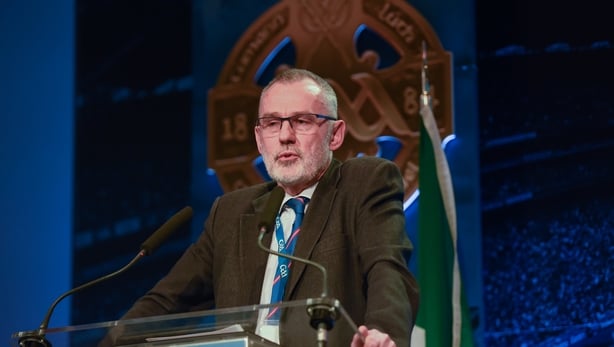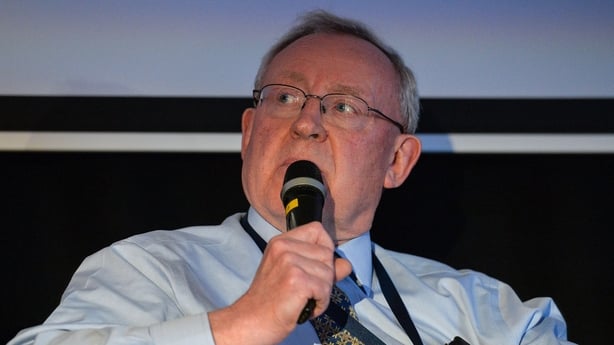The GAA believes that a move to establish Under-19 as the new minor grade at inter-county level and keep U17 games as strictly developmental will address burnout and help with the retention of young players.
Both issues were raised in 2007 by a GAA medical group, chaired by Dr Pat O'Neill.
And once again the topic of age grades and development of young players will be one of the main topics of consideration at congress in Bekan, Co Mayo, on Saturday.
Senior GAA officials believe that this proposed change is a crucial part of their new Gaelic Games Player Pathway and tackles the balance between young players at club and county and the threat of overuse injuries.
They insist that the move will help them achieve their goal of life-long participation in Gaelic games and that U19 is a more appropriate age to start at inter-county level than U17.
For the past number of years there have been several debates on what the GAA's underage club and inter-county structure should look like.
The initial call for change from U18 to U17 came for several reasons, including anecdotal and empirical evidence highlighting incidence of overuse injuries and player burnout in developing players, clashes with state exams and over-burdening of young players at that age due to fixture overlap between underage and adult competitions. Evidence of player drop-off peaking between ages of 15 and 17 years was a key factor too.
The switch from U21 to U20 has caused plenty of debate too with some in the association looking for a return to the traditional U18 and U21 model.
On the other hand, there have been calls for U17 to be scrapped and for an U23 grade to be established to keep developing players in contention for longer.

In his opening address at Congress 2020, GAA President Larry McCarthy identified the current gap in underage structures, between U17 and U20 as one that required consideration.
The association are also concerned at data revealing the amount of 'overuse’ injuries coming from U17 level and want to ensure greater balance between club and county activity with players available for their clubs at U17 and below.
A motion was deferred to Central Council in 2020 where a club wanted action on ensuring their players would always be available regardless of their involvement on development squads. Included also was a proposal to limit training time with inter-county underage squads.
At the heart of the GAA Player Pathway is the club and people like Michael Dempsey and Brian Cuthbert were key players in the development of the pathway – proposing that clubs be part of the player development process and not peripheral.
Successive reports have advised that U17 is too young for national competition and have instead recommended that the highest championship grade before adult participation should be U19.
The GAA are conscious too of the increased focus on these games via social media platforms and feel that a more developmental approach can lead to better player wellbeing.
Central Council this weekend submits a motion that Rule 6.28 (E) (F) (H) – Governing the All-Ireland minor and U-20 football and hurling championships – Official Guide (Part 1) – be temporarily set aside in 2023, 2024 and 2025 to allow for the introduction of an U19 Minor All-Ireland football and hurling Championship.
The format and age span will be determined by Central Council.
If successful U19 would be established as the new minor grade at club level for introduction in 2023. There is an acceptance that U20 would also be organised in 2023 to ensure players don’t lose out.
It would then be the new grade and first recognised inter-county age grade in terms of formal All-Ireland competition for introduction in 2023.
There may well be opposition to this motion given that two clubs – one in Cavan and another in Longford are proposing the GAA revert to U18 minor championship at inter-county with varied degrees of eligibility. Other motions on the Clár are also seeking to dispense with Central Council age-grade policy for clubs.
The view is that with two years of a congested competition calendar caused by the pandemic – the new age-grade policy has not had the opportunity to be embedded and allowed to deliver on its aim to increase participation and retention within the pathway.
GAA Director of Coaching and Games Development Shane Flanagan, however, says the reasoning for pinpointing U19 as the new minor grade is well founded.
"In essence all we are trying to implement the player pathway and provide the right support at the right time for players by providing a meaningful developmental experience for all our players," We are trying to finally get right what has been identified on so many occasions previously" he says.
"Between 2004 and 2015 eight reports looked at fixtures scheduling, burnout and impact of players and clubs," he says. Experts such as Dr Pat O’Neill, Dr Niall Moyna and many more including members of our Medical Science and Welfare Committee have all supported the decoupling of underage and adult based on hard medical evidence related to overuse injuries and player burnout.

Indeed, the Taskforce chaired by Dr Pat O'Neill in 2007, were the first group to recommend U19 at inter-county and the introduction of an U17 development competition along with proposals related to eligibility, training sessions, competitions, and coach education interventions to increase awareness among coaches of the risks associated with overtraining and burnout.
A key reason for recommending U19 by these medical people was that by ‘raising the age-threshold at county level to U19 will provide greater bone and joint maturity and thereby reduce the risk of musculoskeletal injuries.’
Running throughout the Report of the Taskforce on Player Burnout was the need for young talented players to have balance in their lives and by that be connected to their clubs. The authors were strong on the view that inter-county U19 would ensure more players would be with their clubs post that grade.
"Since then, we've had the Talent Academy Player Development group, chaired by Mick Dempsey and more recently the Fixture Calendar Review Committee," Flanagan adds.
"A common theme runs throughout from all of their findings. That is to provide more balance and a player centred approach to games provision at U20 down and especially at U17.
"Decoupling juvenile and adult has made a huge improvement - but with the same competition structures at Inter-County remaining at U17 as existed at -18, the environment and training regime has not changed with the same pressures on players - only now they're younger.
Flanagan says that the GAA’s new pathway to adult participation will focus on both the player and the club.
"At the heart of our new pathway is the club and we'd like to bring balance and stop the situation where adult norms become common practice at youth level and given the large body of medical evidence this is a situation we need to address," he says.
"I would be concerned too of a growing opinion that the split season (brought in to solve adult fixtures) can be implemented at underage and its 'okay for players not to be with their clubs and friends'.
"We know too that de-selection practices are happening sooner in our development squads in preparation for U17 inter-county minor impacting player retention," he stresses. "We have evidence to support that U15 grade is now becoming a preparatory team as such for inter-county U-17.
"We know from a recent study: The Relative Age Effect (RAE) in Gaelic Athletic Association, completed by Jamie Queeney, the Meath GAA Games Manager that " significantly at U-16 players are almost twice as likely to be selected if born in quarter-one of the year which suggests players are being selected primarily because of their physical attributes – which is very high when set against international standards and other sports.
"Yet we also know that there is an even distribution at senior inter-county level suggesting that we need to be inclusive and aware of a player’s developmental needs lower down the player pathway. We want to broaden the base and keep as many players in the system for as long as possible – but do it in a way that integrates the clubs and club coaches" he adds.
In recent years, the GAA has seen the effect and success of its Celtic Challenge model where teams are tiered at U17 level and receive a plethora of games in a developmental fashion. There is a genuine fear that a reverting to U18 inter-county would set the Celtic Challenge model back due to overlap of adult fixtures.
The GAA chief is also concerned that the three years from U17 to U20 is simply too wide.
"As the Uachtarán rightly highlighted, the gap to U20 is a challenge and hence the reason we are recommending U19.
"The two-year gap will be more easily breached - but more importantly it will really support and allow for improved practices below that grade. A 20-year-old is more important to a club senior team than a 19-year-old so this is more favourable to clubs.
"In all the talk about gaps, people ignore the value of second and third level competition. We want to integrate these units into the pathway as outlined.
"Third-level GAA beyond U19 can be reframed and become that stage in the pathway whereby it’s the forum for players to make the 'breakthrough'.
"We also know from speaking with third level that the establishment of U19 will reduce the number of players caught in under-20/Sigerson/Fitzgibbon binds."
The GAA’s annual congress takes place next Saturday at the NUI Galway Connacht GAA Air Dome.


